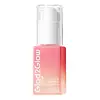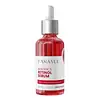What's inside
What's inside
 Key Ingredients
Key Ingredients

 Benefits
Benefits

 Concerns
Concerns

 Ingredients Side-by-side
Ingredients Side-by-side

Water
Skin ConditioningButylene Glycol
HumectantPropylene Glycol
HumectantCaprylic/Capric Glycerides Polyglyceryl-10 Esters
EmollientBetaine
HumectantPrunus Persica Fruit Extract
AbrasiveSqualane
EmollientMadecassoside
AntioxidantRetinol
Skin ConditioningHydroxyacetophenone
Antioxidant1,2-Hexanediol
Skin ConditioningCetearyl Olivate
Pentylene Glycol
Skin ConditioningSorbitan Olivate
EmulsifyingAcrylates/C10-30 Alkyl Acrylate Crosspolymer
Emulsion StabilisingAllantoin
Skin ConditioningO-Cymen-5-Ol
AntimicrobialXanthan Gum
EmulsifyingAminomethyl Propanol
BufferingRetinyl Propionate
Skin ConditioningHydroxypinacolone Retinoate
Skin ConditioningHydroxyphenyl Propamidobenzoic Acid
Skin ConditioningAroma
Quaternium-73
Glycerin
HumectantCaprylic/Capric Triglyceride
MaskingPolysorbate 80
EmulsifyingPolysorbate 20
EmulsifyingPhenoxyethanol
PreservativeEthylhexylglycerin
Skin ConditioningWater, Butylene Glycol, Propylene Glycol, Caprylic/Capric Glycerides Polyglyceryl-10 Esters, Betaine, Prunus Persica Fruit Extract, Squalane, Madecassoside, Retinol, Hydroxyacetophenone, 1,2-Hexanediol, Cetearyl Olivate, Pentylene Glycol, Sorbitan Olivate, Acrylates/C10-30 Alkyl Acrylate Crosspolymer, Allantoin, O-Cymen-5-Ol, Xanthan Gum, Aminomethyl Propanol, Retinyl Propionate, Hydroxypinacolone Retinoate, Hydroxyphenyl Propamidobenzoic Acid, Aroma, Quaternium-73, Glycerin, Caprylic/Capric Triglyceride, Polysorbate 80, Polysorbate 20, Phenoxyethanol, Ethylhexylglycerin
Water
Skin ConditioningNiacinamide
SmoothingSqualane
EmollientGlycerin
HumectantBetaine
HumectantPropylene Glycol
HumectantButylene Glycol
HumectantPropanediol
SolventBiosaccharide Gum-1
HumectantPhenoxyethanol
PreservativeLactic Acid
BufferingMethyl Gluceth-20
HumectantPEG-40 Hydrogenated Castor Oil
EmulsifyingPolysorbate 80
EmulsifyingXanthan Gum
EmulsifyingPolyacrylate Crosspolymer-6
Emulsion StabilisingAllantoin
Skin ConditioningBenzotriazolyl Dodecyl P-Cresol
UV AbsorberCamellia Sinensis Leaf Extract
AntimicrobialDisodium EDTA
Retinol
Skin ConditioningTocopheryl Acetate
AntioxidantTriethylene Glycol
MaskingHydroxypinacolone Retinoate
Skin ConditioningPanthenol
Skin ConditioningCaprylic/Capric Triglyceride
MaskingVaccinium Macrocarpon Fruit Extract
AstringentTetrahydropiperine
Skin Conditioning1,2-Hexanediol
Skin ConditioningHydrogenated Lecithin
EmulsifyingCaprylyl Glycol
EmollientSclerotium Gum
Emulsion StabilisingBisabolol
MaskingArachis Hypogaea Oil
Skin ConditioningAscorbic Acid
AntioxidantBiotin
AntiseborrhoeicFolic Acid
Skin ConditioningPyridoxine Hcl
Skin ConditioningRetinyl Palmitate
Skin ConditioningSucrose Stearate
EmollientTocopherol
AntioxidantCeramide NP
Skin ConditioningHyaluronic Acid
HumectantDimethylmethoxy Chromanol
AntioxidantCeramide AP
Skin ConditioningCeramide As
Skin ConditioningCeramide Ng
Skin ConditioningGlycosphingolipids
EmollientWater, Niacinamide, Squalane, Glycerin, Betaine, Propylene Glycol, Butylene Glycol, Propanediol, Biosaccharide Gum-1, Phenoxyethanol, Lactic Acid, Methyl Gluceth-20, PEG-40 Hydrogenated Castor Oil, Polysorbate 80, Xanthan Gum, Polyacrylate Crosspolymer-6, Allantoin, Benzotriazolyl Dodecyl P-Cresol, Camellia Sinensis Leaf Extract, Disodium EDTA, Retinol, Tocopheryl Acetate, Triethylene Glycol, Hydroxypinacolone Retinoate, Panthenol, Caprylic/Capric Triglyceride, Vaccinium Macrocarpon Fruit Extract, Tetrahydropiperine, 1,2-Hexanediol, Hydrogenated Lecithin, Caprylyl Glycol, Sclerotium Gum, Bisabolol, Arachis Hypogaea Oil, Ascorbic Acid, Biotin, Folic Acid, Pyridoxine Hcl, Retinyl Palmitate, Sucrose Stearate, Tocopherol, Ceramide NP, Hyaluronic Acid, Dimethylmethoxy Chromanol, Ceramide AP, Ceramide As, Ceramide Ng, Glycosphingolipids
Ingredients Explained
These ingredients are found in both products.
Ingredients higher up in an ingredient list are typically present in a larger amount.
1,2-Hexanediol is a synthetic liquid and another multi-functional powerhouse.
It is a:
- Humectant, drawing moisture into the skin
- Emollient, helping to soften skin
- Solvent, dispersing and stabilizing formulas
- Preservative booster, enhancing the antimicrobial activity of other preservatives
Allantoin is a soothing ingredient known for its protective and moisturizingg properties. Because of this, it is often added to products with strong active ingredients.
Studies show higher concentrations of this ingredient can promote wound healing.
Though it can be derived from the comfrey plant, allantoin is produced synthetically for cosmetic products to ensure purity.
Learn more about AllantoinBetaine is a common humectant (a substance that promotes retention of moisture). It's known to be gentle on the skin and can help balance hydration.
This ingredient is best for improving hydration and soothing irritated skin. Studies also show it helps even out skin tone.
Fun fact: Betaine is naturally created in the skin and body. The kind found within cosmetic products can be either plant-derived or synthetic.
Another name for betaine is trimethylglycine.
Learn more about BetaineButylene Glycol (or BG) is used within cosmetic products for a few different reasons:
Overall, Butylene Glycol is a safe and well-rounded ingredient that works well with other ingredients.
Though this ingredient works well with most skin types, some people with sensitive skin may experience a reaction such as allergic rashes, closed comedones, or itchiness.
Learn more about Butylene GlycolThis ingredient is an emollient, solvent, and texture enhancer. It is considered a skin-softener by helping the skin prevent moisture loss.
It helps thicken a product's formula and makes it easier to spread by dissolving clumping compounds.
Caprylic Triglyceride is made by combining glycerin with coconut oil, forming a clear liquid.
While there is an assumption Caprylic Triglyceride can clog pores due to it being derived from coconut oil, there is no research supporting this.
Learn more about Caprylic/Capric TriglycerideGlycerin is already naturally found in your skin. It helps moisturize and protect your skin.
A study from 2016 found glycerin to be more effective as a humectant than AHAs and hyaluronic acid.
As a humectant, it helps the skin stay hydrated by pulling moisture to your skin. The low molecular weight of glycerin allows it to pull moisture into the deeper layers of your skin.
Hydrated skin improves your skin barrier; Your skin barrier helps protect against irritants and bacteria.
Glycerin has also been found to have antimicrobial and antiviral properties. Due to these properties, glycerin is often used in wound and burn treatments.
In cosmetics, glycerin is usually derived from plants such as soybean or palm. However, it can also be sourced from animals, such as tallow or animal fat.
This ingredient is organic, colorless, odorless, and non-toxic.
Glycerin is the name for this ingredient in American English. British English uses Glycerol/Glycerine.
Learn more about GlycerinThis ingredient is a retinoid. It usually goes by a more common name: "Granactive".
Hydroxypinacolone Retinoate (HPR) belongs to the class of retinoids that also includes retinol and tretinoin.
Retinoids have been proven to:
So what is the difference between all the retinoids?
Most retinoids need to go through a conversion line to become effective on skin. The ending product is retinoic acid. Retinoic acid is AKA tretinoin.
HPR is an ester of tretinoin. Emerging studies suggest HPR to have an added benefit that other retinoids don't have: Low irritation.
A study from 2021 found HPR to have the greatest stability when exposed to light and temperature out of all the commercial retinoids.
A note about naming:
The name "Granactive" is the trade name and the name most commonly used on packages.
Granactive is the name of the mixture - about 90% solvent and 10% HPR. A product with 5% granactive has 0.5% HPR.
Learn more about Hydroxypinacolone RetinoatePhenoxyethanol is a preservative that has germicide, antimicrobial, and aromatic properties. Studies show that phenoxyethanol can prevent microbial growth. By itself, it has a scent that is similar to that of a rose.
It's often used in formulations along with Caprylyl Glycol to preserve the shelf life of products.
Polysorbate 80 is a surfactant and emulsifier. It is used to keep ingredients together, and prevent oils and waters from separating.
It is made from polyethoxylated sorbitan and oleic acid. This ingredient can be found in cosmetics, foods, and medicine. It is water-soluble.
Polysorbate 80 may not be fungal acne safe.
Learn more about Polysorbate 80Propylene Glycol is an odorless, colorless liquid. As a humectant, it helps skin retain moisture. It also aids in delivering active ingredients.
Another role of this ingredient is preventing a product from melting or freezing. Propylene glycol also adds antimicrobrial properties to a product, elongating product lifespan.
This ingredient is considered an organic alcohol and commonly added into both cosmetics and foods.
Those with sensitive skin or conditions may develop a rash when using this ingredient.
Learn more about Propylene GlycolRetinol is a gold-standard ingredient for anti-aging. It is a form of Vitamin A and belongs to the class of retinoids that also includes tretinoin.
Why is retinol famous?
It has the most scientific studies backing up its skin benefits out of all the non-prescription ingredients.
Retinol is proven to:
This is why retinol is effective at removing wrinkles, fading dark spots, treating acne, and reducing the appearance of pores.
Studies show retinol is less effective when exposed to UV. Be sure to look for appropriate packaging to keep your retinol potent (similar to Vitamin C).
Using retinol or any retinoids will increase sun-sensitivity in the first few months. Though studies show retinoids increase your skin's natural SPF with continuous use, it is best to always wear sunscreen and sun-protection.
We recommend speaking with a medical professional about using this ingredient during pregnancy.
Retinol may cause irritation in some people, so be sure to patch test. Experts recommend 'ramping up' retinol use: start using this ingredient once a week and work up to using it daily.
Read about Tretinoin
Learn more about RetinolSqualane is an emollient that helps the skin hold onto moisture. It's an oily liquid that occurs naturally in certain types of fish and plant oils.
Because squalane boosts hydration in the skin, it also comes with plenty of benefits: it is an antioxidant and can help fight free radicals and skin damage. Squalane is also found to have a detoxifying effect when applied.
Squalane comes from squalene, which occurs naturally within the sebum of our skin. It is one of the oils our skin produces to keep itself hydrated. Squalane is the hydrogenated version of squalene and has a longer shelf life.
Research shows that squalane is non-irritating (even at 100% concentration).
In general, it's a fantastic ingredient. It does a great job at hydrating the skin, and it's suitable for those with sensitive skin.
The source of squalane may impact malassezia / fungal acne. This is because olive oil derived squalane can contain impurities such as fatty acids and plant waxes. Sugarcane derived squalane is recommended for anyone with malassezia concerns.
Is squalane vegan?
This depends on the source. Squalane can be derived from both plants and animals. Most squalane used in skincare comes from plants.
Please note: the source of squalane is only known if disclosed by the brand. We recommend reaching out to the brand if you have any questions about their squalane.
Read more about squalene with an "e".
Is squalane an oil?
Squalane is often called an oil, but it’s technically not; it’s a hydrocarbon, meaning it’s only made of carbon and hydrogen, unlike true oils which are triglycerides made of fatty acids and glycerol.
The term “oil-free” isn’t regulated, so companies can define it however they want. Some exclude all oils, while others just avoid mineral oil or comedogenic oils.
While some people avoid oils thinking they cause breakouts, the right kind of oil (or oil-like ingredient like squalane) can actually help balance and hydrate your skin. It’s worth testing out simple oils or squalane to see what works best for your skin.
Learn more about SqualaneWater. It's the most common cosmetic ingredient of all. You'll usually see it at the top of ingredient lists, meaning that it makes up the largest part of the product.
So why is it so popular? Water most often acts as a solvent - this means that it helps dissolve other ingredients into the formulation.
You'll also recognize water as that liquid we all need to stay alive. If you see this, drink a glass of water. Stay hydrated!
Learn more about WaterXanthan gum is used as a stabilizer and thickener within cosmetic products. It helps give products a sticky, thick feeling - preventing them from being too runny.
On the technical side of things, xanthan gum is a polysaccharide - a combination consisting of multiple sugar molecules bonded together.
Xanthan gum is a pretty common and great ingredient. It is a natural, non-toxic, non-irritating ingredient that is also commonly used in food products.
Learn more about Xanthan Gum